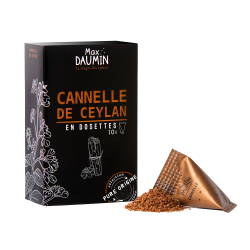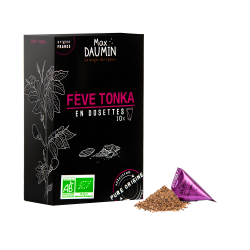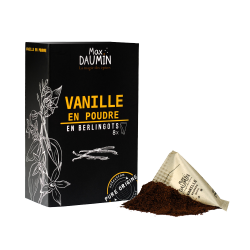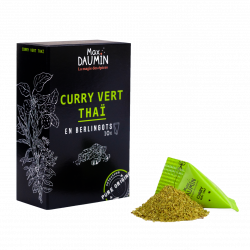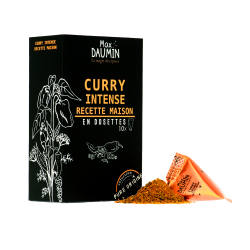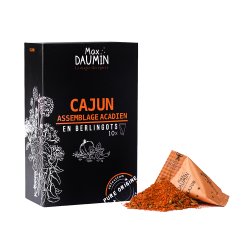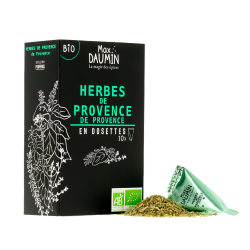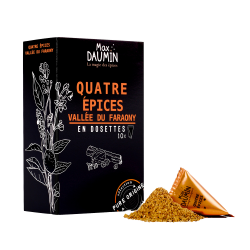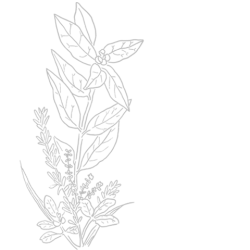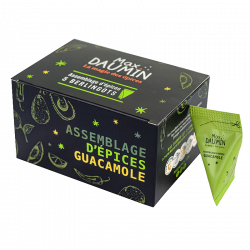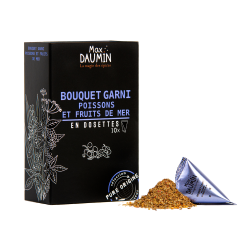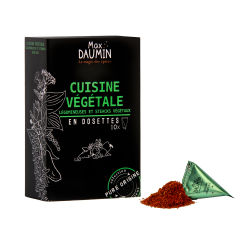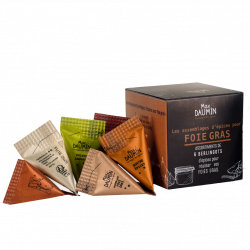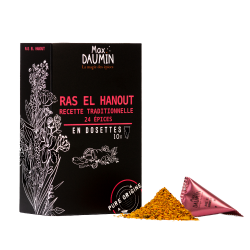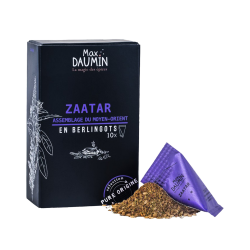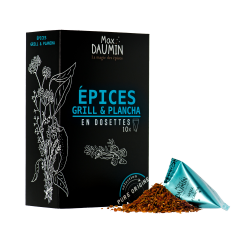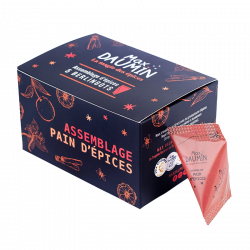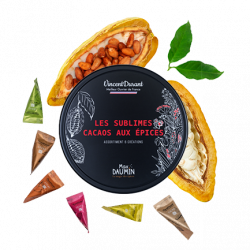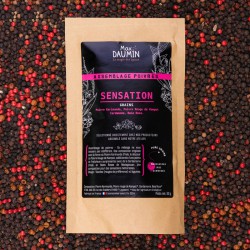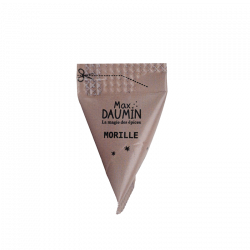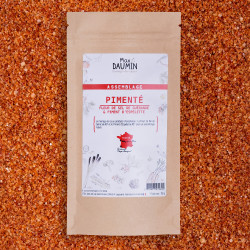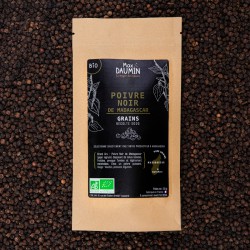-
- Our Berlingots Blends Bouquet Garni from France Fish and Seafood Bouquet Garni Cajun blend Plant-based cuisine Curry Homemade Recipe Curry Intense Homemade Recipe Thaï Red Curry Thaï Green Curry Spices Grill & Plancha Organic Provencal Herbs from Provence Four Spices Faraony Valley Ras El Hanout Traditional Recipe Zaatar Guacamole Spices Mix Gingerbread Spices Mix Coffret Assemblage Foie Gras Mulled Wine Spice Mix
- Pure Spices Berlingots Garlic from France Bear's garlic from Ain Ceylon cinnamon Organic Clove from Madagascar Organic coriander from France Cumin from India Organic turmeric from Madagascar Organic Tonka bean harvested in Guyana Organic ginger from Madagascar Nutmeg from Sri Lanka Sweet Paprika from Hungary Smoked Paprika from Hungary Ancho Rojo pepper from Mexico Bourbon Vanilla Powder – Gourmet
- Berlingot peppers Organic black pepper from Madagascar Voatsiperifery Wild Pepper Treetop pepper
- Espelette pepper Espelette pepper Ezpeletako Biperra
- Berlingot vanilla Bourbon Vanilla Powder – Gourmet
- Bulk ground spices Bouquet Garni from France - Bulk Organic turmeric from Guadeloupe bulk copy of Organic turmeric from Guadeloupe bulk Homemade Recipe Curry - Bulk Grill & Plancha Spices - Bulk Ras El Hanout Traditional Recipe - Bulk Sumac from Sicily bulk
- Vrac berlingots à composer Sachet vrac berlingots
-
- Vanilla pods Bourbon vanilla from Madagascar – Gourmet & Bio Vanilla Tahitensis Haapape Bourbon Vanilla Powder – Gourmet
- Saffron Saffron pistils from Afghanistan - Neguine
- Bulk Spices Star Anise - Badian copy of SilTimur berry or Tchuli pepper Organic Pink Berry from Madagascar Ceylon Cinnamon - Pipes Cardamom Whole Organic Clove Organic coriander from France Organic Fenugreek from France Whole Organic Tonka Bean from Guyana Whole nutmeg Jamaican pepper Pili-Pili Bird Pepper
-
- Peppercorns Yupanqui green pepper Yupanqui black pepper Yupanqui white pepper Smoked Yupanqui black pepper Black pepper from Kampot Organic & PGI Organic & PGI Yellow Kampot Pepper Organic & PGI Red Kampot Pepper Phu Quoc black pepper copy of Phu Quoc black pepper Karimunda pepper – Kerala (India) Black pepper from Madagascar Organic Tasmanian Pepper Berry Voatsiperifery wild pepper from Madagascar Likouala wild pepper Organic Timur wild pepper SilTimur berry or Tchuli pepper Red Sichuan Pepper Wild treetop pepper Blend of Peppers - Sensation Blend of Peppers - Explosion - Organic Blend of Peppers - Impression
- Crystal salts Pink Himalayan Salt - Crystals Persian Blue Salt - Crystals Hiwa Kai black salt from Hawaii Kala Namak salt or Himalayan black salt - Crystals Black Forest Smoked Salt Utah Sweet Salt - Crystals Guérande Flower of Salt
- Salts and Spices Blend Salts - Sauvage Organic Salt Blend - Lemon Blend of Organic Salts - Fou Blend Salts - Spicy Organic Cinq Baies Salt Blend - Scented
- de Buyer pepper mills De Buyer Rumba Pepper Mill - Steel Mechanism De Buyer Natural Wood Jota Pepper Mill De Buyer Boogie Pepper Mill Natural Wood - Steel Mechanism Mixed Salt/Pepper Moulin de Buyer De Buyer Paso Pepper Mill Natural Wood De Buyer Paso Pepper Mill Dark Wood De Buyer Boogie mixt Salt Pepper Mill
- de Buyer salt mills De Buyer Rumba Salt Mill - Steel Mechanism De Buyer Salt Mill JOTA Ebony De Buyer Salt Mill Boogie Natural Wood - Steel Mechanism Mixed Salt/Pepper Moulin de Buyer
- de Buyer nutmeg mill De Buyer SOKO Nutmeg Mill
- Box de Buyer mill & Kampot pepper De Buyer Pepper Mill Box + Organic Kampot Black Pepper & PGI
-
- Spiced Tea box The Fabulous spiced teas
- Thé Chaï Classic Chai tea Chaï Ayurvédique Chaï Masala Détox Chaï Cardamome Bombay Cutting Chai
- Berlingot Spiced Tea Berlingot Classic Chai tea Berlingot Ayurvedic Chaï tea Berlingot Cardamom Chaï tea Berlingot Masala Detox Chaï tea Berlingot Bombay Cutting Chaï tea
-
- Spiced cocoa boxes The sublime cocoas with spices The sublime cocoas with spices & exotic fruits Box of 6 cocoas with spices
- Berlingot Cocoa Berlingot Cocoa Tonka Vanilla Berlingot Cocoa Raspberry Rose Cardamom Berlingot Cocoa Combava Timur Cocoa Berlingot Sweet Orange Ceylon Cinnamon Berlingot Cocoa Grand Cru Plain Berlingot Cocoa Ginger of Madagascar Berlingot Cocoa Litchi Ceylan Cinnamom Berlingot Cocoa Passion Fruit Lemongrass Berlingot Cocoa Dragon Fruit Strawberry Sichuan green Berlingot Cocoa Cherry Tonka beans Berlingot Cocoa Espelette Pepper
- Chocolat aux épices Coffret Chocolat aux épices - Route des Indes
-
- Boxes to compose 20 Spices box 3 Flavors box Box of 6 cocoas with spices Box 3 boxes Sachet vrac berlingots
- Gift boxes Enhance your everyday ! Surprise your guests! Delight your loved ones! The Fabulous spiced teas The sublime cocoas with spices The sublime cocoas with spices & exotic fruits Coffret Chocolat aux épices - Route des Indes De Buyer Pepper Mill Box + Organic Kampot Black Pepper & PGI
- Integrals Integral 14 Integral 18 Integral 20
- Assortment Box Guacamole Spices Mix Gingerbread Spices Mix Coffret Assemblage Foie Gras Mulled Wine Spice Mix
- Miels Miel & Vanille Bourbon copy of Miel & Vanille Bourbon copy of Miel & Vanille Bourbon copy of Miel & Vanille Bourbon
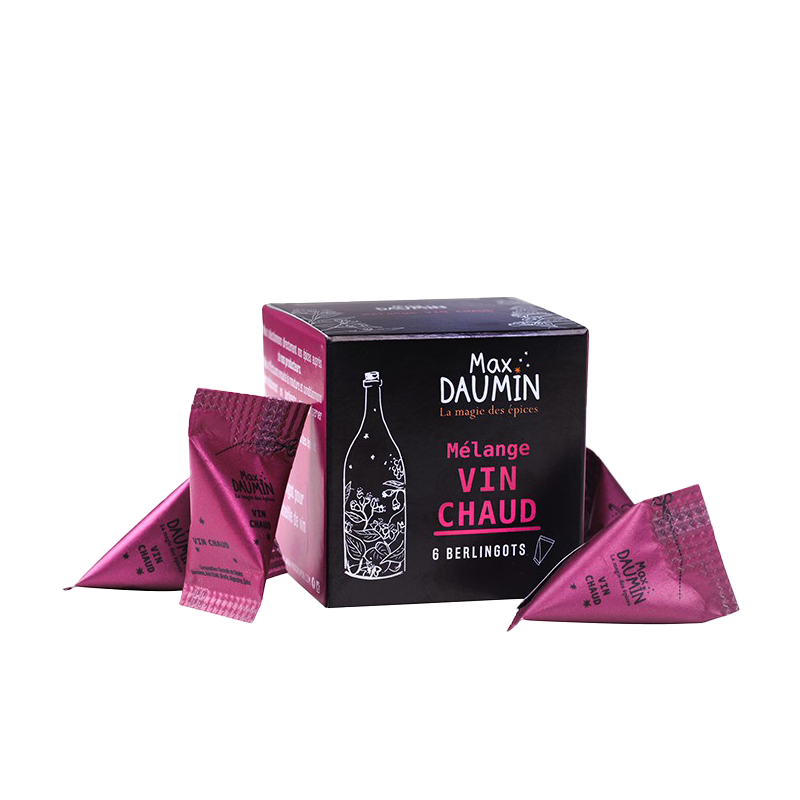





Mulled Wine Spice Mix
A single carton for a bottle of wine, brown sugar and that's it! Heat it up and it's done.
Our mulled wine blend is powerful and aromatic. It is made up of five spices: Ceylon cinnamon, star anise, clove, ginger and kaffir lime which will bring lemony and orange citrus notes.
Each spice is selected directly from our producers, no intermediary. All the warmth of this blend is warmly preserved in a carton.
This spice mix is also perfect for making your Christmas cookies!
Box of 6 cartons therefore 6 bottles :)
-
Net weight : 10g
-
Composition : Ceylon Cinnamon, Star Anise, Ginger, Cardamom, Clove, Combava, Nutmeg
-
Dimensions :
-
Recyclable box and berlingots : Sorting paper / cardboard


History
Plant & perfume
Our spice mix for mulled wine is made up of 4 spices and a citrus fruit: Ceylon cinnamon with its subtle notes of roses and its lemony and sweet hints, star anise for its warm aniseed flavor, ginger for its lemony notes and a hint of clove for its peppery, powerful and caramelized touches.
We add combava mussel bark which brings intense notes of citrus and lemongrass.
Ceylon cinnamon (Cinnamomum Zeylanicum), kaffir lime (Citrus hystrix), ginger (Zingiber officinale) and clove (Syzygium aromaticum) come from our direct selection from Madagascar. Star anise or star anise (Illicium verum) comes from India.


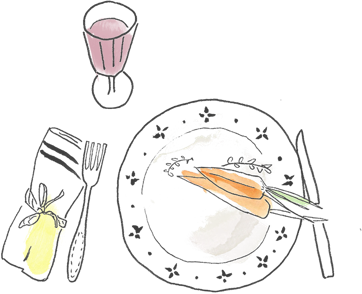
Benefits
Cooking and Virtue
The virtues of mulled wine are festive, comforting and warm in winter!
Recipe for our mulled wine for 4 to 6 people: Pour a bottle of wine (75cl) into a saucepan. Prefer a fruity wine (Hauts Côtes du Rhône or Burgundy) Add the contents of a mulled wine carton and 40 to 100 g of brown sugar according to taste. Turn off the heat just before boiling, let infuse. It's ready ! You can add a drop of white port or old rum.
During preparation, the wine should never boil but simply simmer.
You can also use this assembly to make your Christmas cookies. It fits perfectly.

Origins
A long journey
Since antiquity, spices have been associated with wine. In Roman times the conditum paradoxum was a mixture of wine and honey; to this were added pepper, mastic (resin of the pistachio tree, Pistacia lentiscus), saffron, bay leaf and nard (Nardostachys jatamansiplante whose fragrant rhizome is used).
Roman expansion popularized spiced wines across Europe. The recipes of hypocras in the Middle Ages then brought sweeter notes; cinnamon, cloves and citrus fruits are also added.


Frequently asked questions

You might also like
Organic Tonka bean harvested in Guyana
Bourbon vanilla from Madagascar – Gourmet & Bio
Bourbon Vanilla Powder – Gourmet

16 other products in the same category:
Thaï Green Curry
Curry Intense Homemade Recipe
Notify me when available
Sign up and get notification when product will be available again.
Cajun blend
Organic Provencal Herbs from Provence
Four Spices Faraony Valley
Bouquet Garni from France
Guacamole Spices Mix
Fish and Seafood Bouquet Garni
Curry Homemade Recipe
Plant-based cuisine
Coffret Assemblage Foie Gras
Ras El Hanout Traditional Recipe
Notify me when available
Sign up and get notification when product will be available again.
Zaatar
Thaï Red Curry
Spices Grill & Plancha
Gingerbread Spices Mix

Customers who bought this product also bought:
The sublime cocoas with spices
Notify me when available
Sign up and get notification when product will be available again.
Blend of Peppers - Sensation
Utah Sweet Salt - Crystals
Berlingot Morille
Blend Salts - Spicy
Bouquet Garni from France
Organic Salt Blend - Lemon
Black pepper from Madagascar Organic






check_circle
check_circle



